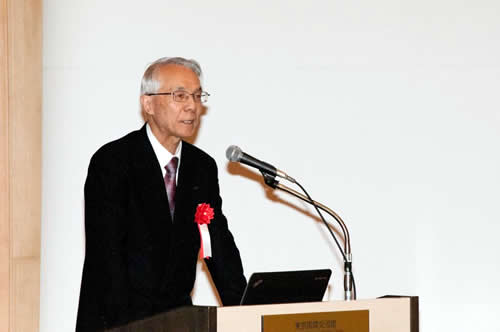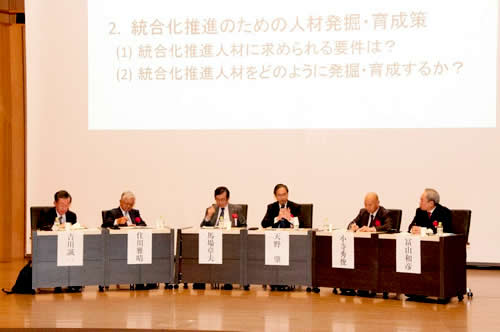(前半 anterior half) 講演/Speech
(後半 latter half) パネルディスカッション/Panel Discussion
少子高齢化やエネルギー問題など、現代の複雑な課題はひとつの学問だけでは解決できません。これらの問題の解決には、多様な学問を統合化させることが必要だと言われています。アゴラキーノートセッション1では「統合化」をキーワードに、科学的な学問をはじめ、技術開発、プロジェクトマネジメントなど、さまざまな観点から、科学技術イノベーションの実現に向けた統合化について議論されました。
Today’s complex problems such as an aging society with a low birth rate, and energy issues are beyond the ability of any single discipline to solve adequately. The integration of various disciplines is increasingly required to address these problems. In Agora Keynote Session 1, integration for science and technology based innovation was discussed from different viewpoints, which includes scientific disciplines, technological development and project management, with the keyword integration.
20世紀に科学は分野ごとに細分化。それによって、個々の学問は発展しました。しかし、少子高齢化やエネルギー問題など、21世紀の抱える課題は複雑になっていて、視野の狭いひとつの学問だけでは解決できません。そこで、個々の学問はもちろん、発展した様々な知識を「統合化」することで科学技術イノベーションを生み出し、これらの問題を解決することが期待されています。
In the 20th century, science has been divided into different disciplines and each has been developed, but problems we face in the 21st century, such as an aging society with a low birth rate and energy issues, are becoming more complex, and are beyond the ability of any single discipline with a narrow scope to solve adequately. Therefore, it is expected that these problems will be solved through science and technology-based innovation by integrating knowledge and experiences in not only academic disciplines but also industry.
セッションの冒頭では、科学技術振興機構研究開発戦略センター(CRDS)センター長の吉川弘之氏が挨拶を行いました。産学官の連携や、大学・企業・地域との連携が進みつつある現在において「現実の行動をもって統合すべきだ。その行動が新たな知恵を生む。現実の統合を通じて、人間の知識が統合する」と述べました。
At the start of the session, Hiroyuki Yoshikawa, Director-General of the Center for Research and Development Strategy (CRDS) in the Japan Science and Technology Agency(JST), gave an address. Referring to the current situation where cooperation between universities, companies, government and local communities are progressing, Dr. Yoshikawa said, “integration should be achieved through action. Action will create new wisdom. Integration of action will result in integration of human knowledge”.
続いて文部科学省科学技術・学術政策局長の川上伸昭氏は「統合化において、専門家が異なる領域の知識を理解するのは難しいと思われる。行政にできることがあれば協力したい」として、議論に期待を寄せました。
Following the address by Dr. Yoshikawa, Nobuaki Kawakami, Director-General of the Science and Technology Policy Bureau, the Ministry of Education, Culture, Sports, Science and Technology (MEXT), said, “in the integration process, it is perhaps difficult for experts to understand knowledge in different areas from their own. We would like to help if there is anything the government can do”. Mr. Kawakami then expressed his expectations for discussions in the session.

科学技術振興機構理事長の中村道治氏は、ものづくりを得意とする、日本らしい知の統合を目指したいと掲げました。知の統合という観点では、超LSI技術研究組合など、70年代から90年代にかけて一定の成果を生み出しています。しかし「当時は同分野の企業や関連施設が集まったものだ」(中村氏)として、これからは異分野の融合や連携が欠かせないと言います。
Michiharu Nakamura, President of JST, stated he would like to aim for the integration of knowledge based on Japan’s strong manufacturing. With regard to integration of knowledge, some national projects such as the VLSI Technology Research Association have produced results between the 1970s to 1990s. However, Dr. Nakamura said each project in that period had been conducted by companies in the same industry and related intuitions. He explained that interdisciplinary and interindustry activities and cooperation would be essential in the future.
国内の例として、異分野融合・連携型の基盤的テーマを支援するセンター・オブ・イノベーション(COI)プログラムに触れました。「10年後の社会ビジョンを意識したもの」(中村氏)というCOIプログラムでは、企業所属のプロジェクトリーダーと、大学や研究機関所属の研究リーダーが連携した研究開発チームを作っています。COIプログラムなどを通じて「新しいことに積極的にチャレンジできるような社会を目指す」と中村氏は意気込みました。
As an example of current projects in Japan, Dr. Nakamura introduced the Center of Innovation(COI) Program which supports fundamental, multi- and interdisciplinary R&D challenges. According to him, each project under the COI Program has set a 10 year vision and built a R&D team led by a project leader from a company in cooperation with a research leader from a university or a research institute. Dr. Nakamura expressed a strong desire to create a society, through the COI Program and related projects, where everyone tries something new.

経営共創基盤代表取締役CEOである冨山和彦氏は、産業の視点から「ビジネスにおいて強力なプラットフォーマーとキーコンポーネントプレーヤーが生まれてほしい」と願います。日本は、基礎研究から産業化するステップが弱いとされており、この弱点は「死の谷」とも言われています。また、産業を興しても海外にプラットフォームをもっていかれるということが、特に製造業では多く見受けられます。
Kazuhiko Toyama, CEO of Industrial Growth Platform Inc., addressed the expectation that strong platfomers and key component players in business would be emerged in Japan. It is pointed out that Japan is not successful in bringing basic research to the market, i.e., crossing the gap called “the valley of death.” Also, there are many cases, particularly in the manufacturing industry, where a foreign company has established a platform for a new business created by a Japanese company.
強力なプラットフォーマーを作るためには、プロジェクトマネージャーの育成が必要だと冨山氏は考えます。「アカデミアと産業、またはアカデミア同士、産業同士をつなぐ人材の育成が必要だ」としたうえで「日本の風土を考えると、最終的には大企業がプラットフォーマーになると考えている。だが大企業も、ベンチャー企業と連携することが必要だろう」と述べました。
Mr. Toyama stated that development of project managers is required in order to produce strong platfomers. He emphasized that human resources who bridge the gap between academia and industry, among academia or industry should be developed. He added, “when considering Japanese business culture, big companies will eventually become platfomers while they will need to cooperate with venture companies”.
「大学の使命は、2050年を見てやるべきことを提供すること」と話したのが京都大学教授の小寺秀俊氏です。大学においても研究分野が細分化しており、企業と連携しようにも、お互いの目的がマッチングしないという事態もあるとのこと。そのような場合においても、「他の人を紹介できるようなネットワークを用意すること、そして全体を取りまとめる『コンダクター(指揮者)』の存在が求められる」(小寺氏)と主張します。
Hidetoshi Kotera, Professor at Kyoto University, pointed out that a mission of a university is to provide a vision of society in 2050. He explained that research fields have been divided at universities and it is not easy to share the objectives of collaboration between academia and industry. Prof. Kotera argued it is necessary to establish a network of contacts to help find a partner, and also find aconductor, someone who directs all the activities in a project.
京都大学には、2015年春に国際科学イノベーション棟が完成予定。国際科学イノベーション棟には40以上の大学、研究機関、企業などが入居します。「これからイノベーションを起こすには、既存技術を集めることが必要だと考えている。そのうえで、大学、研究機関、企業をどう巻き込むか」(小寺氏)が課題と言います。
At Kyoto University, the International Innovation Center will be launched in spring, 2015, and will accommodate over 40 branches of universities, research institutes and companies. Prof. Kotera said it is necessary for innovation in the future to incorporate existing technologies and to involve the universities, research institutes and companies.
特定非営利活動法人ITS Japan専務理事の天野肇氏は、交通システム開発に携わってきた現場の立場から「地域からの統合化」というアプローチを紹介しました。平成20年度から平成24年度にかけて実施された社会還元加速プロジェクト「情報通信技術を用いた安全で効率的な道路交通システムの実現」において、ITS実証実験モデル都市の例を紹介しました。
Hajime Amano, Executive Director of ITS Japan, introduced an approach to “integration emerged in a region”, from his experiences in transportation system development. He introduced the approach of model cities for intelligent transport systems (ITS) demonstration tests in the project Establishment of Safe and Efficient Transport Systems with ICT, which was part of the Social Benefit Acceleration Projects between 2008 and 2012.
青森県青森市において国・県・市が連携して道路の除雪情報を提供するシステム、新潟県五泉市で導入された基幹バスと乗合タクシーの組み合わせの例などを紹介しながら、「統合化は、行政や大企業が参加する前に、すでに地域レベルで実施されている。地域には、ベンチャー企業などの担い手が多くいる。地域から国へという流れもあっていいのでは」と提案しました。
Mr. Amano demonstrated other examples, such as a system for information about snow removal on roads in Aomori City, which is operated in cooperation with the central and local governments, and a combination of key route bus and shared taxi services introduced in Gosen City, Niigata. He then stated, “integration has already been implemented at the regional level, even before the governments and big companies take part in the process. There are venture companies and many other players in the integration process in regions. An integration process from the regional to the national level could be possible”.
教育という立場からは、大阪大学理事・副学長の馬場章夫氏が「教育は大学だけでなく企業とも連携して進めるもの」として、大阪大学の事例を紹介しました。大阪大学では1994年に教養部が廃止され、専門性が重視されるようになりました。しかし現在は、総合力や異分野の融合が求められる時代であり、教育プロセスの見直しを進めていると言います。主専攻以外の副専攻の授業も受講できるような仕組みを作り、学生が多くの分野に触れられるように工夫しています。
Akio Baba, Vice President of Osaka University, introduced examples of integration at Osaka University from aneducation perspective, noting that education should be promoted not only by universities themselves but also in cooperation with companies. In 1994, Osaka University abolished the liberal arts college and prioritized expertise development. However, Dr. Baba stated the university promotes education reforms to meet the demand of the age for integrated skills and multidisciplinary knowledge. The university offers a dual degree program allowing students to take both major and minor classes and learn multiple disciplines.
また大阪大学では、産学連携の場としてテクノアライアンス棟を利用しています。現在は37の共同研究講座、6の協働研究所が入居中。企業研究員が常駐することで、異業種が交流できるような仕組みとなっています。「統合化では、いかに優秀な人を集められるかがポイント。テクノアライアンス棟に代表される産学連携は、人材育成も目的であり、大学にとっても大きな財産になる」と馬場氏は強調しました。
Osaka University has prepared the TechnoAlliance Complex facilities for industry-academia collaboration. Currently, the complex accommodates 37 Joint Research Chairs and six Collaborative Research Laboratories where researchers from each company devote full time to their duties and encourage cross-industry interaction. Dr. Baba emphasized, “a key to successful integration is how to attract excellent human resources. Human resource development is one of the objectives of industry-academia cooperation as represented by activities in the TechnoAlliance Complex, and would be a valuable asset for the university”.
セッションの後半では、パネルディスカッションが行われました。冨山氏、小寺氏、天野氏、馬場氏に加え、モデレーターにCRDS上席フェローの吉川誠一氏、コメンテーターに産業競争力懇談会実行委員会委員長の住川雅晴氏が参加しました。
A panel discussion was held in the latter half of the session. In addition to Mr. Toyama, Prof. Kotera, Mr. Amano and Dr. Baba, Seiichi Yoshikawa, Principal Fellow of CRDS, and Masaharu Sumikawa, Chairman of the Council on Competitiveness-Nippon (COCN) Working Committee, joined the discussion as a moderator and a commentator respectively.

パネルディスカッションでは、「統合化では、何を実現するのか、課題は何か」「統合化推進のために求められる人材とは何か、どのように発掘、育成するか」を主な論点として議論が展開されました。
The panel discussion focused on what integration should achieve and what the challenges are, and what kinds of human resources are necessary for integration, and how they are identified and developed.
「統合化では、何を実現するのか、課題は何か」については、やはり少子高齢化やエネルギー問題を解決するためという意見が出ました。また課題については、「基礎研究から応用研究、実用化研究を同時に行うことが必要」(小寺氏)、「工学系だけでなく人文科学や社会学との統合化も求められる」(馬場氏)、「アカデミアにおける相互理解や相互コミュニケーションの不足を解消すべき」(住川氏)といった意見がありました。
In the discussion on what integration should achieve and what the challenges are, problems of aging population and low birth rate, as well as energy issues were pointed out. Suggestions to solve problems included, “conducting basic, applied and commercial research concurrently”(Prof. Kotera), “integrating not only engineering subdisciplines but also with humanities and social science”(Dr. Baba), and “overcoming communication barriers within academia”(Dr. Sumikawa).
また「統合化推進のために求められる人材とは何か、どのように発掘、育成するか」については、「誰も体験したことがない問題を咀嚼して挑戦できるような人材が求められる」(天野氏)として、「キャリアパスは縦方向ではなく横方向に自由に動くことを推奨すべき」(冨山氏)、という提案が出ました。コメンテーターの住川氏は「知識付与型から疑問解決型への教育にシフトして、多様性を認めるべきだろう」と言いました。
In the discussion on what kinds of human resources are necessary for integration, and how they are identified and developed, Mr. Amano stated, “we need person who can assimilate and address unprecedented problems”. Mr. Toyama then proposed, “not a vertical but a horizontal movement should be encouraged in career”. Dr. Sumikawa, the commentator, noted we should shift the education focus from knowledge offering to problem solving and a deeper appreciation for diversity.
最後に、CRDS副センター長の中原徹氏は「日本にはいろいろな壁があるが、壁の先に知恵が詰まっている。その知恵を統合化して総動員しなければ、現在の複雑化した課題は解決できないだろう。そのためには、統合化するための場所を用意すべきだ。また、パネルディスカッションでも議論されたように、異分野や異業種をつなげる人材が必要だ」として、セッションを締めくくりました。
Lastly, Toru Nakahara, Deputy Director-General of CRDS, concluded the session by addressing, “while many barriers exist in Japan, all the treasure of wisdom and knowledge are hidden behind the barriers. Unless we could integrate and utilize them, we could not solve complex problems. In order to achieve this, we should facilitate integration. We also need human resources who bridge the gap between different disciplines and industries, as argued in the panel discussion”.
下記のリンクからご覧ください。